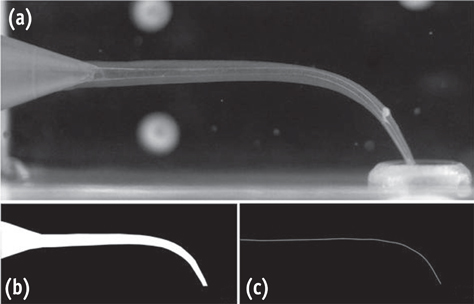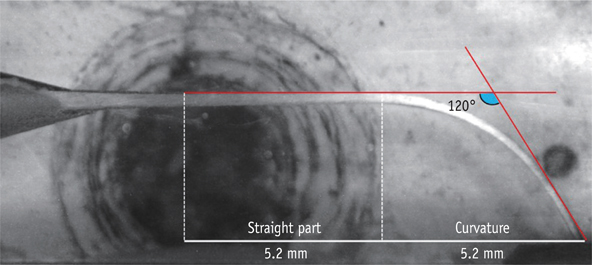Restor Dent Endod.
2016 Feb;41(1):1-5. 10.5395/rde.2016.41.1.1.
Comparison of canal transportation in simulated curved canals prepared with ProTaper Universal and ProTaper Gold systems
- Affiliations
-
- 1Department of Endodontics, Grande Rio University (UNIGRANRIO) School of Dentistry, Rio de Janeiro, RJ, Brazil. nogueiraemmanuel@hotmail.com
- 2Department of Paediactric Dentistry, Rio de Janeiro Federal University, Rio de Janeiro, RJ, Brazil.
- 3Department of Endodontics, Federal University of Maranhao School of Dentistry, Sao Luis, MA, Brazil.
- KMID: 2316957
- DOI: http://doi.org/10.5395/rde.2016.41.1.1
Abstract
OBJECTIVES
The purpose of this study was to assess the ability of ProTaper Gold (PTG, Dentsply Maillefer) in maintaining the original profile of root canal anatomy. For that, ProTaper Universal (PTU, Dentsply Maillefer) was used as reference techniques for comparison.
MATERIALS AND METHODS
Twenty simulated curved canals manufactured in clear resin blocks were randomly assigned to 2 groups (n = 10) according to the system used for canal instrumentation: PTU and PTG groups, upto F2 files (25/0.08). Color stereomicroscopic images from each block were taken exactly at the same position before and after instrumentation. All image processing and data analysis were performed with an open source program (FIJI). Evaluation of canal transportation was obtained for two independent canal regions: straight and curved levels. Student's t test was used with a cut-off for significance set at alpha = 5%.
RESULTS
Instrumentation systems significantly influenced canal transportation (p < 0.0001). A significant interaction between instrumentation system and root canal level (p < 0.0001) was found. PTU and PTG systems produced similar canal transportation at the straight part, while PTG system resulted in lower canal transportation than PTU system at the curved part. Canal transportation was higher at the curved canal portion (p < 0.0001).
CONCLUSIONS
PTG system produced overall less canal transportation in the curved portion when compared to PTU system.
Figure
Cited by 2 articles
-
Micro-computed tomographic evaluation of a new system for root canal filling using calcium silicate-based root canal sealers
Mario Tanomaru-Filho, Fernanda Ferrari Esteves Torres, Jader Camilo Pinto, Airton Oliveira Santos-Junior, Karina Ines Medina Carita Tavares, Juliane Maria Guerreiro-Tanomaru
Restor Dent Endod. 2020;45(3):e34. doi: 10.5395/rde.2020.45.e34.Comparison of vibration characteristics of file systems for root canal shaping according to file length
Seong-Jun Park, Se-Hee Park, Kyung-Mo Cho, Hyo-Jin Ji, Eun-Hye Lee, Jin-Woo Kim
Restor Dent Endod. 2020;45(4):e51. doi: 10.5395/rde.2020.45.e51.
Reference
-
1. Bergmans L, Van Cleynenbreugel J, Wevers M, Lambrechts P. Mechanical root canal preparation with NiTi rotary instruments: rationale performance and safety. Status report for the American Journal of Dentistry. Am J Dent. 2001; 14:324–333.2. Gergi R, Rjeily JA, Sader J, Naaman A. Comparison of canal transportation and centering ability of twisted files, Pathfile-ProTaper system, and stainless steel hand K-files by using computed tomography. J Endod. 2010; 36:904–907.
Article3. McGuigan MB, Louca C, Duncan HF. Endodontic instrument fracture: causes and prevention. Br Dent J. 2013; 214:341–348.
Article4. De-Deus G, Neves A, Silva EJ, Mendonça TA, Lourenço C, Calixto C, Lima EJ. Apically extruded dentin debris by reciprocating single-file and multi-file rotary system. Clin Oral Investig. 2015; 19:357–361.
Article5. Bergmans L, Van Cleynenbreugel J, Beullens M, Wevers M, Van Meerbeek B, Lambrechts P. Smooth flexible versus active tapered shaft design using NiTi rotary instruments. Int Endod J. 2002; 35:820–828.
Article6. Hieawy A, Haapasalo M, Zhou H, Wang ZJ, Shen Y. Phase transformation behavior and resistance to bending and cyclic fatigue of ProTaper Gold and ProTaper Universal instruments. J Endod. 2015; 41:1134–1138.
Article7. Ajuz NC, Armada L, Gonçalves LS, Debelian G, Siqueira JF Jr. Glide path preparation in S-shaped canals with rotary pathfinding nickel-titanium instruments. J Endod. 2013; 39:534–537.
Article8. Giuliani V, Di Nasso L, Pace R, Pagavino G. Shaping ability of WaveOne primary reciprocating files and ProTaper system used in continuous and reciprocating motion. J Endod. 2014; 40:1468–1471.
Article9. Silva EJ, Tameirão MD, Belladonna FG, Neves AA, Souza EM, De-Deus G. Quantitative transportation assessment in simulated curved canals prepared with an adaptive movement system. J Endod. 2015; 41:1125–1129.
Article10. Schneider CA, Rasband WS, Eliceiri KW. NIH Image to ImageJ: 25 years of image analysis. Nat Methods. 2012; 9:671–675.
Article11. Schindelin J, Longair M. Rigid 3D alignment of stacks. updated 2015 Feb 3. Available from: http://132.187.25.13/home/?category=Download&page=RigidRegistration.12. Lee TC, Kashyap RL, Chu CN. Building skeleton models via 3-D medial surface axis thinning algorithms. Comput Vis Graph Image Process. 1994; 56:462–478.
Article13. Thomson SA, Dummer PM. Shaping ability of Hero 642 rotary nickel-titanium instruments in simulated root canals: part 2. Int Endod J. 2000; 33:255–261.
Article14. Hülsmann M, Stryga F. Comparison of root canal preparation using different automated devices and hand instrumentation. J Endod. 1993; 19:141–145.
Article15. Gagliardi J, Versiani MA, de Sousa-Neto MD, Plazas-Garzon A, Basrani B. Evaluation of the shaping characteristics of ProTaper Gold, ProTaper NEXT, and ProTaper Universal in curved canals. J Endod. 2015; 41:1718–1724.
Article16. Bonaccorso A, Cantatore G, Condorelli GG, Schäfer E, Tripi TR. Shaping ability of four nickel-titanium rotary instruments in S-shaped canals. J Endod. 2009; 35:883–886.
Article17. Dummer PM, Alodeh MH, al-Omari MA. A method for the construction of simulated root canals in clear resin blocks. Int Endod J. 1991; 24:63–66.
Article18. Zhang L, Luo HX, Zhou XD, Tan H, Huang DM. The shaping effect of the combination of two rotary nickel-titanium instruments in simulated S-shaped canals. J Endod. 2008; 34:456–458.
Article19. Hartmann MS, Barletta FB, Camargo Fontanella VR, Vanni JR. Canal transportation after root canal instrumentation: a comparative study with computed tomography. J Endod. 2007; 33:962–965.
Article20. Junaid A, Freire LG, da Silveira Bueno CE, Mello I, Cunha RS. Influence of single-file endodontics on apical transportation in curved root canals: an ex vivo micro-computed tomographic study. J Endod. 2014; 40:717–720.
Article21. Gergi R, Osta N, Bourbouze G, Zgheib C, Arbab-Chirani R, Naaman A. Effects of three nickel titanium instrument systems on root canal geometry assessed by micro-computed tomography. Int Endod J. 2015; 48:162–170.
Article22. Bergmans L, Van Cleynenbreugel J, Wevers M, Lambrechts P. A methodology for quantitative evaluation of root canal instrumentation using microcomputed tomography. Int Endod J. 2001; 34:390–398.
Article23. Yoo YS, Cho YB. A comparison of the shaping ability of reciprocating NiTi instruments in simulated curved canals. Restor Dent Endod. 2012; 37:220–227.
Article24. Lim YJ, Park SJ, Kim HC, Min KS. Comparison of the centering ability of WaveOne and Reciproc nickel-titanium instruments in simulated curved canals. Restor Dent Endod. 2013; 38:21–25.
Article
- Full Text Links
- Actions
-
Cited
- CITED
-
- Close
- Share
- Similar articles
-
- A comparative study of the canal configuration after shaping by protaper rotary and hand files in resin simulated canals
- Root canal volume change and transportation by Vortex Blue, ProTaper Next, and ProTaper Universal in curved root canals
- Comparison of shaping ability using various Nickel-Titanium rotary files and hybrid technique
- A comparative study on the canal configuration after shaping by ProFile, ProTaper(TM) and K-Flexofile in simulated canals with different angles of curvature
- Relative efficacy of three Ni-Ti file systems used by undergraduates



